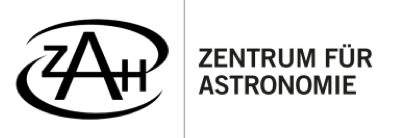MKEP5 Astronomical Techniques
Core course for Master students, listed on Moodle and heiCO
Course content (short summary): Concepts, technologies, and physical principles of modern observational techniques, along with their scientific applications. Includes optical telescopes and detectors, imaging and spectroscopy, characterization of data, effect of the atmosphere, multi-wavelength and particle astronomy.
Lecturer: Priv.-Doz. Dr. Anna Pasquali
Time and location: Tuesday and Thursday 9:15 - 11, Grösser Hörsaal (gHS), Philosophenweg 12
Lectures will start on Thursday April 15th 2025. Tutorials will begin on Monday/Tuesday April 28th/29th.
Homeworks: Homework sheets become available every Tuesday on Moodle and have to be submitted by Tuesday of the following week to the lecturer before the start of the lecture. We encourage solving and submitting the homework in groups; the maximum is 3 people.
Prerequisites: Knowledge of the introductory astronomy lectures (MVAstro0 or WPAstro). Basic knowledge on electromagnetic radiation.
Credit points: 8
Literature:
- P. Léna, "Observational Astrophysics", Springer
- F.R. Chromey, "To Measure the Sky", Cambridge University Press
- C.R. Kitchin, "Astrophysical Techniques", CRC Press
Additional recommendations for specific parts of the lecture:
- S.B. Howell, "Handbook of CCD Astronomy", Cambridge University Press
- I. Appenzeller, "Introduction to Astronomical Spectroscopy", Cambridge University Press
- D.J. Schroeder, "Astronomical Optics", Academic Press
Exam: To be fixed
50% of homework points are required for participating in the exam.
Course content and planned schedule:
- 01 April 15th: Lecture organization; Coordinates and time
- 02 April 17th: Atmospheric extinction and airmass; Geometric optics: focal length and image scale
- 03 April 22nd: Optical aberrations and telescope design
- 04 April 24th: Instrumental diffraction and Airy-PSF
- 05 April 29th: First part of optical detectors and CCDs
- 06 May 6th: Second part of optical detectors and CCDs
- 07 May 8th: The night sky; S/N calculation
- 08 May 13th: Spectroscopy 1: gratings-grisms-prims, basic mathematical relations
- 09 May 15th: Spectroscopy 2: scientific information at different wavelength and resolution: SED and population models, redshift, rotation/dispersion; IFUs
- 10 May 20th: Imaging data: flux, magnitudes, noise
- 11 May 22nd: Imaging data reduction, spectroscopic reduction
- 12 May 27th: Imaging data analysis: photometry; Spectroscopic data analysis: line centers, equivalent widths; Flux calibratios
- 13 June 3rd: Atmospheric turbulence and seeing
- 14 June 5th: Active Optics, Adaptive Optics
- 15 June 10th: Observation and analysis of the Sun
- 16 June 12th: Web-based access of data and measurements; Observational tools
- 17 June 17th: Near-, mid-, and far-infrared Astronomy (detectors and instrumentation, science)
- 18 June 24th: Radio astronomy (detectors and instrumentation, science)
- 19 June 26th: Interferometry: concepts, optical/near-infrared, radio
- 20 July 1st: UV astronomy
- 21 July 3rd: X-ray astronomy: detectors and science
- 22 July 8th: Gamma-ray astronomy and particle astronomy
- 23 July 10th: Neutrino astronomy; Gravitational wave astronomy; Gravitational lensing; Observational cosmology
- 24 July 15th: Questions and answers
- JULY ??: Exam: 9:00-11:00
